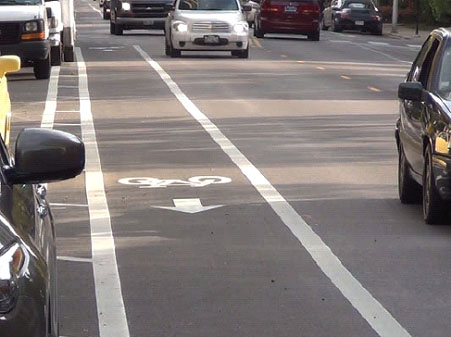TTAP Newsletter: RoadTalk
How Wide Should Your Bicycle Lane Be?
Source: "NCHRP Report 766 - Recommended Bicycle Lane Widths for Various Roadway Characteristics"
The 2012 edition of the American Association of State Highway and Transportation Officials' Guide for the Development of Bicycle Facilities (AASHTO, 2012), often referred to as the Bike Guide, defines a bicycle lane as "a portion of a roadway that has been designated for preferential or exclusive use by bicyclists by pavement markings and, if used, signs. It is intended for one-way travel, usually in the same direction as the adjacent traffic lane, unless designed as a contra-flow lane."
The Bike Guide states that, in most situations, the recommended width for bike lanes is 5ft, but in some circumstances, wider bicycle lane widths may be desirable, while in other cases a 4-ft-wide bike lane can be used. Additional research was done to develop recommendations for bicycle lane widths for various roadway and traffic characteristics. The focus of the research was in developing design guidance for bicycle lane widths for roadways in urban and suburban areas.

General Conclusions
1. A buffered bike lane provides distinct advantages over simply providing a wider bike lane.
2. Narrowing the width of a bicycle lane reduces the variability of the bicyclists' lateral positions; however, this impact is relatively minor, at least for the bicycle lane widths evaluated in the research.
3. As traffic volume increases, bicyclists move away from vehicles in the travel lane and position themselves closer to parked vehicles or the curb.
4. As truck percentage within the vehicle mix increases, bicyclists move away from vehicles in the travel lane and position themselves closer to parked vehicles or the curb.
5. For streets with on-street parking and where the parking lane width is between 7ft and 9ft and the bike lane width is between 4ft and 6ft, the effective bike lane will likely be less than the physical width of a typical adult bicyclist, and the majority of bicyclists will position themselves outside of the effective bike lane.
6. For streets without on-street parking, as long as the adjacent travel lane is at least 10-ft wide and the bike lane is 4ft to 5ft in width, most bicyclists will position themselves in the effective bike lane, and the effective bike lane will be equivalent to the width of the marked bike lane.

Design Guidance
1.
Travel lanes between 10ft and 12ft in width are appropriate for streets with a bicycle lane.
2.
At sites with travel lane widths between 16ft and 18ft on streets without on-street parking, marking a bicycle lane provides no distinct advantages for the lateral positioning of bicyclists and motorists. While this statement is true with respect to the issues addressed in this particular study, there are other reasons why bike lanes on streets with 16ft to 18ft lanes would be desirable. These include using the bike lane to narrow the travel lane to provide a traffic calming measure; encouraging bicyclists to travel in the correct direction on the street; getting bicyclists off of adjacent sidewalks; and using the bike lane as a link to a larger bikeway network.
3.
In most situations where a bicycle lane is adjacent to on-street parking, the suggested width for the parking lane is 8 ft. An 8ft parking lane provides sufficient space for a large percentage of vehicles to park within the limits of the parking lane, and it is narrow enough that it allows more of the roadway cross section to be designated for bicyclists in the bicycle lane and motor vehicles in the travel lanes. This is consistent with current recommendations in the AASHTO Bike Guide.
4.
The AASHTO Bike Guide states that under most circumstances, the recommended width for bike lanes is 5ft. The guide also states that under certain conditions, wider bicycle lanes may be desirable. In particular, the guide states that when adjacent to a narrow parking lane (7ft) with high turnover, a wider bicycle lane (6ft to 7ft) provides more operating space for bicyclists to ride outside of the door zone of parked vehicles. Based on the data collected in this study, a 6ft bicycle lane does not provide additional benefits to bicyclists compared to a 5ft bicycle lane. Most bicyclists will still position themselves within the open door zone of parked vehicles whether in a 6ft bicycle lane or a 5ft bicycle lane. A 7ft bicycle lane may offer distinct advantages for bicyclists compared to bicycle lane widths of 5ft and 6ft; however, data for 7ft bike lanes were not investigated in this research. Where space permits, the data suggest that installing a narrower bicycle lane with a parking-side buffer provides distinct advantages over a wider bike lane with no buffer.
5.
For parking lanes that are 7ft to 9ft wide, assuming the 95th-percentile parked vehicle displacement and an open door width of 45 in., the open door zone width of parked vehicles extends approximately 11ft from the curb. Therefore, the design of the bike lane should encourage bicyclists to ride outside of this door zone area and account for the width of the bicyclist.
For additional information on NCHRP Report 766 - "Recommended Bicycle Lane Widths for Various Roadway Characteristics" please go to: http://onlinepubs.trb.org/onlinepubs/nchrp/nchrp_rpt_766.pdf
Back-Contents-Forward
